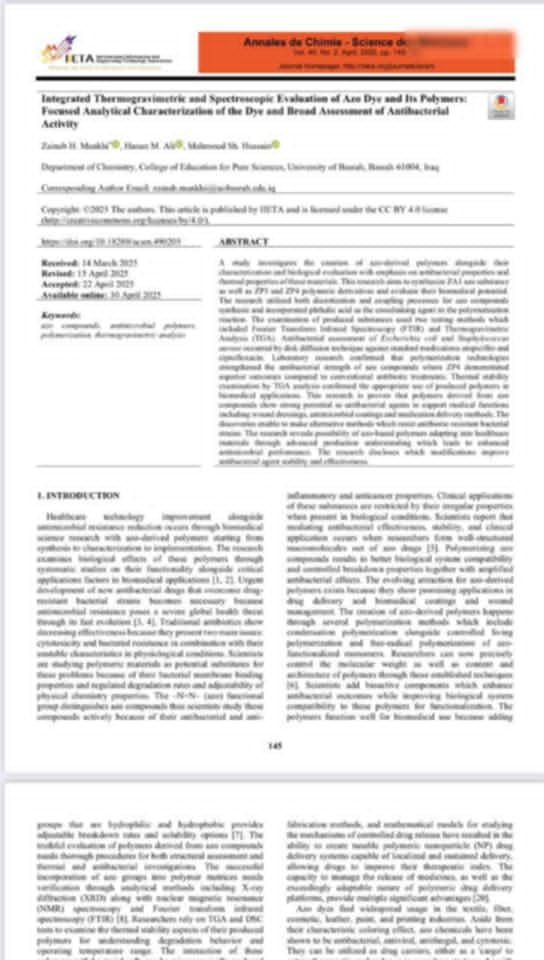
A research team from the Department of Chemistry, consisting of graduate/master's student Zainab Hashim Mankhi, Assistant Professor Hanan Murtadha Ali, and Professor Mahmoud Shaker Hussein, both lecturers at the University of Basra, published a study titled "Integrated Thermogravimetric and Spectroscopic Evaluation of Azo Dye and Its Polymers: Focused Analytical Characterization of the Dye and Broad Assessment of Antibacterial Activity" by Zainab H. Mankhi*, Hanan M. Ali, and Mahmoud Sh. Hussain
(Integrated Thermogravimetric and Spectroscopic Evaluation of Azo Dye and its Polymers: A Focused Analytical Characterization of the Dye and a Comprehensive Evaluation of its Antibacterial Activity)
Published in the French journal Annales de Chimie - Sciences des Matériaux (Scopus Q3)
The study concluded the production of azo-derived polymers, along with their biological characterization and evaluation, with a focus on their antibacterial and thermal properties. This research aims to synthesize the azo compound ZA1, as well as the polymer derivatives ZP3 and ZP4, and evaluate their biomedical potential. The research used both diazo and coupling processes to synthesize the azo compounds, and incorporated phthalic acid as a crosslinking agent in the polymerization reaction. Two methods were used to test the resulting materials, including Fourier transform infrared spectroscopy (FTIR) and thermogravimetric analysis (TGA). Antibacterial evaluation of Escherichia coli and Staphylococcus aureus was conducted using the disk diffusion technique against the standard drugs ampicillin and ciprofloxacin. Laboratory investigations confirmed that polymerization techniques enhanced the antibacterial potency of azo compounds, with ZP4 demonstrating superior results compared to conventional antibiotic treatments. Thermal stability assay using TGA confirmed the appropriate use of the produced polymers in biomedical applications. This research demonstrated that azo-derived polymers exhibit strong potential as antibacterial agents to support medical applications, including wound dressings, antimicrobial coatings, and drug delivery vehicles. These discoveries enable the development of alternative methods to combat antibiotic-resistant bacterial strains. The research reveals the potential for adapting azo-based polymers to healthcare materials through advanced understanding of production, leading to improved antimicrobial performance. The research also reveals modifications that improve the stability and efficacy of the antibacterial agent
 .
.







